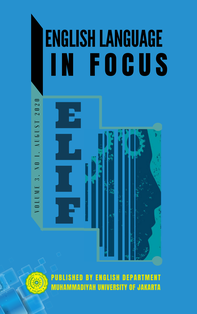Textual Study of How Eun Hwan Portrays Introverted Character in “Introverted Boss” Movie
DOI:
https://doi.org/10.24853/elif.3.1.11-22Keywords:
introverted characters, causes, and efforts, introvert Boss movieAbstract
The aim of this study is (1) to describe the signs of an introverted character, (2) to understand the main actor's introverted character in Introverted Boss, (3) to see why "Eun Hwan Gi" became an introvert, and (4) to identify Eun Gi's efforts to get rid of his introverted character. The research highlights the Introvert personality of the main character in the Introvert Boss film. This type of research is qualitative and focuses on descriptive-analytical methods. This research is qualitative and focuses on methods that are descriptive and analytical. The researcher himself was the instrument used in this study and encouraged in the data inventory format. Eun Hwan Gi had six introverted traits, including social weaknesses, shyness, fear, too much perception, fear, and closeness. The main reasons the main actor has become an introvert are family pressure factors and verbal abuse. In addition to the signs, training, playing games, and developing relationships are the foremost efforts of the actor to minimize such personality. Based on the findings of the research, the film Introverted Boss can be used to identify signs of an introverted character as a reference analysis material. In addition to the sign, the analysis focuses on the reasons for an introvert and Eun Hwan Gi's efforts to reduce his introverted character.References
Abraham, I. (2017). Struktur Kepribadian Tokoh dalam Novel Surat Kecil untuk Tuhan Karya Agnes Davonar. KEMBARA: Jurnal Keilmuan Bahasa, Sastra, Dan Pengajarannya (e-Journal), 3(1), 55–63. https://doi.org/10.22219/KEMBARA.V3I1.4378
American Psychological Association. (2020). Shyness. American Psychological Association. https://www.apa.org/topics/shyness
Ashton, M. C., Lee, K., & Paunonen, S. V. (2002). What is the central feature of extraversion? Social attention versus reward sensitivity. Journal of Personality and Social Psychology, 83(1), 245–252. https://doi.org/10.1037/0022-3514.83.1.245
Asmara, R., & Kusumaningrum, W. R. (2018). Pembongkaran Puitik terhadap Diksi-Diksi Gender dalam Sajak-Sajak Dorothea: Kontra Hegemoni Dunia Penciptaan Kaum Lelaki. Poetika, 6(1), 1. https://doi.org/10.22146/poetika.v6i1.34842
Boroujeni, A. A. J., Roohani, A., & Hasanimanesh, A. (2015). The Impact of Extroversion and Introversion Personality Types on EFL Learners’ Writing Ability. Theory and Practice in Language Studies, 5(1). https://doi.org/10.17507/tpls.0501.29
Burger, J. M. (2019). Personality (10th ed.). Cengage Learning.
Camodeca, M., & Goossens, F. A. (2005). Aggression, Social Cognitions, Anger and Sadness in Bullies and Victims. Journal of Child Psychology and Psychiatry and Allied Disciplines, 46(2), 186–197. https://doi.org/10.1111/j.1469-7610.2004.00347.x
Chapman, L. (2016). 8 Myths About Introverts That We Need to Stop Believing. Introvert, Dear. https://introvertdear.com/news/myths-about-introverts-that-we-need-to-stop-believing/
Ismawati, E. (2013). Pengajaran Sastra. Ombak.
Jones, W. H., Briggs, S. R., & Smith, T. G. (1986). Shyness. Conceptualization and Measurement. Journal of Personality and Social Psychology, 51(3), 629–639. https://doi.org/10.1037/0022-3514.51.3.629
Karnik, B., Sheikh, S., & Ahmad, J. (2015). The Role of English Literature in Re-Construction Society. Journal of Culture, Society and Development, 7, 1–3. https://doi.org/10.1.1.1018.7987
Larsen, R. J., Buss, D. M., Wismeijer, A., Song, J., & Berg, S. M. van den. (2017). Personality psychology: Domains of knowledge about human nature. McGraw Hill Education.
McCrae, R. R., & Terracciano, A. (2005). Personality Profiles of Cultures: Aggregate Personality Traits. Journal of Personality and Social Psychology, 89(3), 407–425. https://doi.org/10.1037/0022-3514.89.3.407
Nelson, P. A., & Thorne, A. (2012). Personality and Metaphor Use: How Extraverted and Introverted Young Adults Experience Becoming Friends. European Journal of Personality, 26(6), 600–612. https://doi.org/10.1002/per.1839
Nuraeni, C. (2016). A Psychopath Analysis on Amy’s Character In Gone Girl Movie. Wanastra: Jurnal Bahasa Dan Sastra, 8(2), 46–52. https://doi.org/10.31294/W.V8I2.2109
Peck, D., & Whitlow, D. (2019). Approaches to Personality Theory. Routledge.
Rosida, E. R., & Astuti, T. P. (2015). Perbedaan Penerimaan Teman Sebaya Ditinjau dari Tipe Kepribadian Ekstrovert dan Introvert. Empati, 4(1), 77–81. https://ejournal3.undip.ac.id/index.php/empati/article/view/13120
Satalina, D. (2014). Kecenderungan Perilaku Cyberbullying Ditinjau dari Tipe Kepribadian Ekstrovert dan Introvert. . Jurnal Ilmiah Psikologi Terapan, 02(02), 2301–8267. https://doi.org/10.22219/JIPT.V2I2.2003
Trianto, T. (2013). Film Sebagai Media Belajar. Graha ilmu.
Wang, J. (2020). An Analysis of Salieri in Amadeus from Freudian Personality Theory: Id, Ego, Superego. 3rd International Conference on Interdisciplinary Social Sciences & Humanities (SOSHU 2020). https://doi.org/10.25236/soshu.2020.015
Wikipedia. (2020). Introverted Boss. Wikipedia. https://en.wikipedia.org/wiki/Introverted_Boss
Downloads
Published
Issue
Section
License
Authors who publish with this journal agree to the following terms:
- Authors retain copyright and grant the journal right of first publication with the work simultaneously licensed under a Creative Commons Attribution License that allows others to share the work with an acknowledgment of the work's authorship and initial publication in this journal.
- Authors can enter into separate, additional contractual arrangements for the non-exclusive distribution of the journal's published version of the work (e.g., post it to an institutional repository or publish it in a book), with an acknowledgment of its initial publication in this journal.
- Authors are permitted and encouraged to post their work online (e.g., in institutional repositories or on their website) before and during the submission process, as it can lead to productive exchanges, as well as earlier and greater citation of published work (See The Effect of Open Access).

